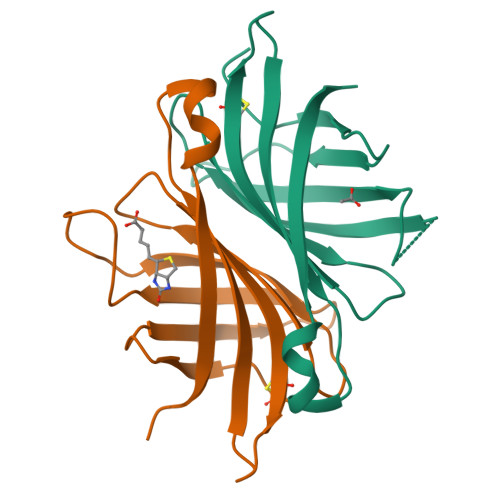Structural and Functional Characteristics of Xenavidin, the First Frog Avidin from Xenopus Tropicalis.
Maatta, J.A.E., Helppolainen, S.H., Hytonen, V.P., Johnson, M.S., Kulomaa, M.S., Airenne, T.T., Nordlund, H.R.(2009) BMC Struct Biol 9: 63
- PubMed: 19788720
- DOI: https://doi.org/10.1186/1472-6807-9-63
- Primary Citation of Related Structures:
2UYW, 2UZ2 - PubMed Abstract:
Avidins are proteins with extraordinarily high ligand-binding affinity, a property which is used in a wide array of life science applications. Even though useful for biotechnology and nanotechnology, the biological function of avidins is not fully understood. Here we structurally and functionally characterise a novel avidin named xenavidin, which is to our knowledge the first reported avidin from a frog. Xenavidin was identified from an EST sequence database for Xenopus tropicalis and produced in insect cells using a baculovirus expression system. The recombinant xenavidin was found to be homotetrameric based on gel filtration analysis. Biacore sensor analysis, fluorescently labelled biotin and radioactive biotin were used to evaluate the biotin-binding properties of xenavidin - it binds biotin with high affinity though less tightly than do chicken avidin and bacterial streptavidin. X-ray crystallography revealed structural conservation around the ligand-binding site, while some of the loop regions have a unique design. The location of structural water molecules at the entrance and/or within the ligand-binding site may have a role in determining the characteristic biotin-binding properties of xenavidin. The novel data reported here provide information about the biochemically and structurally important determinants of biotin binding. This information may facilitate the discovery of novel tools for biotechnology.
Organizational Affiliation:
Institute of Medical Technology, Biokatu 6, FI-33014 University of Tampere and Tampere University Hospital, Tampere, Finland. juha.maatta@uta.fi




















